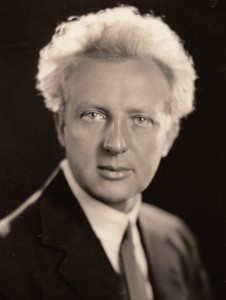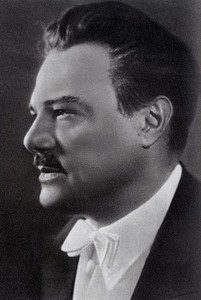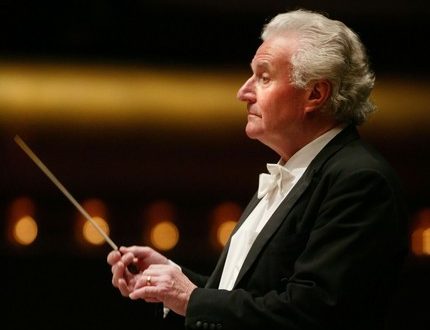
Leopold Stokowski |
Leopold Stokowski

The powerful figure of Leopold Stokowski is uniquely original and multifaceted. For more than half a century, it has risen on the artistic horizon of the world, delighting tens and hundreds of thousands of music lovers, causing fierce debate, puzzling with unexpected riddles, striking with tireless energy and eternal youth. Stokowski, a bright, unlike any other conductor, a fiery popularizer of art among the masses, the creator of orchestras, a youth educator, a publicist, a movie hero, became an almost legendary figure in America, and beyond its borders. Compatriots often called him the “star” of the conductor’s stand. And even taking into account the propensity of Americans to such definitions, it is difficult to disagree with this.
Music permeated his whole life, making up its meaning and content. Leopold Anthony Stanislav Stokowski (this is the full name of the artist) was born in London. His father was Polish, his mother was Irish. From the age of eight he studied piano and violin, then studied organ and composition, and also conducting at the Royal College of Music in London. In 1903, the young musician received a bachelor’s degree from Oxford University, after which he improved himself in Paris, Munich, and Berlin. As a student, Stokowski worked as organist at St James’s Church in London. He initially took this position in New York, where he moved in 1905. But soon an active nature led him to the conductor’s stand: Stokowski felt an urgent need to address the language of music not to a narrow circle of parishioners, but to all people. He made his debut in London, holding a series of open-air summer concerts in 1908. And the next year he became the artistic director of a small symphony orchestra in Cincinnati.
Here, for the first time, the brilliant organizational data of the artist appeared. He quickly reorganized the team, increased its composition and achieved a high level of performance. The young conductor was talked about everywhere, and soon he was invited to lead the orchestra in Philadelphia, one of the largest musical centers in the country. Stokowski’s period with the Philadelphia Orchestra began in 1912 and lasted almost a quarter of a century. It was during these years that both the orchestra and the conductor gained worldwide fame. Many critics consider its beginning to be that day in 1916, when Stokowski first conducted in Philadelphia (and then in New York) Mahler’s Eighth Symphony, the performance of which caused a storm of delight. At the same time, the artist organizes his series of concerts in New York, which soon became famous, special music subscriptions for children and young people. The democratic aspirations prompted Stokowski to an unusually intense concert activity, to search for new circles of listeners. However, Stokowski experimented a lot. At one time, for example, he abolished the position of accompanist, entrusting it to all the orchestra members in turn. One way or another, he manages to achieve truly iron discipline, the maximum return on the part of the musicians, their strict fulfillment of all his requirements and the complete fusion of the performers with the conductor in the process of making music. At concerts, Stokowski sometimes resorted to lighting effects and the use of various additional instruments. And most importantly, he managed to achieve tremendous impressive power in interpreting a wide variety of works.
During that period, Stokowski’s artistic image and his repertoire were formed. Like every conductor of this magnitude. Stokowski addressed all areas of symphonic music, from its origins to the present day. He owns several virtuoso orchestral transcriptions of works by J. S. Bach. The conductor, as a rule, included in his concert programs, combining music of different eras and styles, widely popular and little-known works, undeservedly forgotten or never performed. Already in the first years of his work in Philadelphia, he included many novelties in his repertoire. And then Stokovsky showed himself as a convinced propagandist of new music, introduced Americans to many works by contemporary authors – Schoenberg, Stravinsky, Varese, Berg, Prokofiev, Satie. Somewhat later, Stokowski became the first in America to perform works by Shostakovich, which, with his help, quickly gained immense popularity in the United States. Finally, under the hands of Stokowski, for the first time, dozens of works by American authors – Copland, Stone, Gould and others – sounded. (Note that the conductor was active in the American League of Composers and a branch of the International Society for Contemporary Music.) Stokowski barely worked at the opera house, but in 1931 he conducted the American premiere of Wozzeck in Philadelphia.
In 1935-1936, Stokowski made a triumphant tour of Europe with his team, giving concerts in twenty-seven cities. After that, he leaves the “Philadelphians” and for some time devotes himself to work on radio, sound recording, cinema. He performs in hundreds of radio programs, promoting serious music for the first time on such a scale, records dozens of records, starred in the films The Big Radio Program (1937), One Hundred Men and One Girl (1939), Fantasia (1942, directed by W. Disney ), “Carnegie Hall” (1948). In these films, he plays himself – the conductor Stokowski and, thus, serves the same cause of familiarizing millions of moviegoers with music. At the same time, these paintings, especially “One Hundred Men and One Girl” and “Fantasy”, brought the artist unprecedented popularity all over the world.
In the forties, Stokowski again acts as an organizer and leader of symphony groups. He created the All-American Youth Orchestra, making trips around the country with him, the City Symphony Orchestra of New York, in 1945-1947 he led the orchestra in Hollywood, and in 1949-1950, together with D. Mitropoulos, led the New York Philharmonic. Then, after a break, the venerable artist became the head of the orchestra in the city of Houston (1955), and already in the sixties he created his own group, the American Symphony Orchestra, on the basis of the liquidated NBC orchestra, in which young instrumentalists were brought up under his leadership. and conductors.
All these years, despite his advanced age, Stokowski does not reduce his creative activity. He makes many tours of the United States and Europe, constantly looking for and performing new compositions. Stokovsky shows a constant interest in Soviet music, including in the programs of his concerts works by Shostakovich, Prokofiev, Myaskovsky, Gliere, Khachaturian, Khrennikov, Kabalevsky, Amirov and other composers. He advocates friendship and cooperation between musicians from the USSR and the USA, calling himself “an enthusiast for the exchange between Russian and American culture.”
Stokowski first visited the USSR in 1935. But then he did not give concerts, but only got acquainted with the works of Soviet composers. After that Stokowski performed Shostakovich’s Fifth Symphony for the first time in the USA. And in 1958, the famous musician gave concerts with great success in Moscow, Leningrad, Kyiv. Soviet listeners were convinced that time had no power over his talent. “From the very first sounds of music, L. Stokowski dominates the audience,” wrote critic A. Medvedev, “forcing them to listen and believe what he wants to express. It captivates listeners with its strength, brightness, deep thoughtfulness and precision of execution. He creates boldly and originally. Then, after the concert, you will reflect, compare, ponder, disagree on something, but in the hall, during the performance, the art of the conductor affects you irresistibly. L. Stokowski’s gesture is extremely simple, succinctly clear… He holds himself strictly, calmly, and only at moments of abrupt transitions, climaxes, occasionally allows himself a spectacular wave of his hands, a turn of the body, a strong and sharp gesture. Surprisingly beautiful and expressive are the hands of L. Stokowski: they just ask for sculpture! Each finger is expressive, capable of conveying the slightest musical touch, expressive is a large brush, as if floating through the air, so visibly “drawing” the cantilena, an unforgettable energetic wave of a hand clenched into a fist, commanding the introduction to the pipes … ”Leopold Stokowski was remembered by everyone who has ever come into contact with his noble and original art…
Lit.: L. Stokowski. Music for everyone. M., 1963 (ed. 2nd).
L. Grigoriev, J. Platek, 1969





